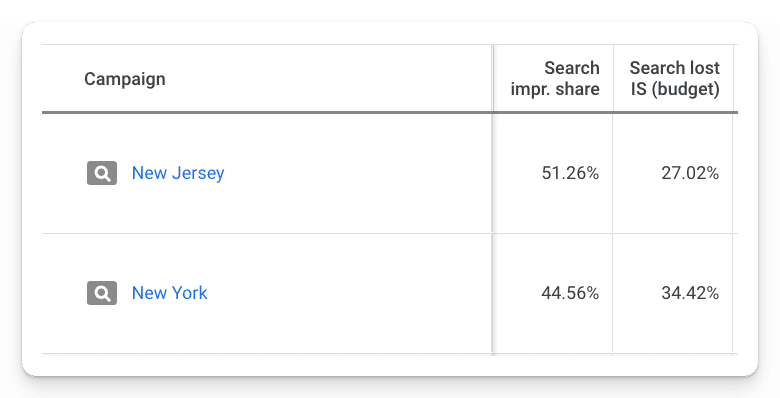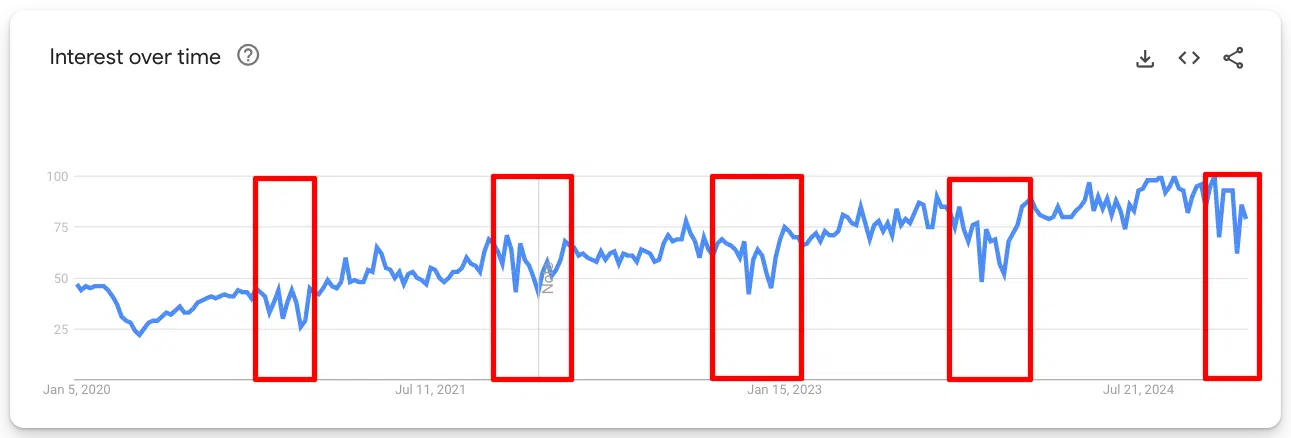Picture this:
A campaign you manage has been doing well for months. One day, you check on the performance only to see that conversions have dipped.
If you work with Google Ads long enough, you’ll inevitably encounter this situation.
However, what sets exceptional PPC marketers apart is their ability to prevent the problem from escalating and take control with confidence.
When conversions decline, clients aren’t happy.
The solution is singular and straightforward: Increase the campaign’s traffic volume, conversion rate, and conversion volume.
You’ll typically want to do this as you reduce the CPA or increase ROAS (both of which can suffer when conversions dip) while staying within budget.
10 common causes of low conversions in Google Ads
Seeing a dip in conversions can be worrying, especially if clients ask questions you can’t answer immediately or if there are other issues with the account.
It might be tempting to jump into the settings and start making changes, but that’s rarely the smart move.
Zoom out with a cool head, and you might discover that the reason conversions are dropping is easily fixable.
Here’s the checklist we use at my agency to diagnose the root cause of low conversions and fix them.
1. Not enough traffic
Before you can look at conversions, you must ensure you’re driving enough traffic. But how much traffic is enough?
Every account is different, so look at your data and work backward.
Typically, every account needs a certain number of clicks to generate a conversion and a certain amount of impressions to generate a click.
When the numbers are off at the top of that chain, they affect the KPIs at the bottom.
Say your account gets one conversion for every 10 clicks and one click for every 100 impressions.
If your campaign receives fewer than 10 clicks per day, you’re probably not hitting that threshold of 100 impressions, and there likely won’t be any conversions.
If this is the case, your goal must be to increase traffic and clicks. If your budget is being spent in full, you can achieve this by increasing your spend.
But if your budget isn’t being used up, that’s where you want to look next.
2. Campaign limited by budget
Most of the time, you’ll find that conversions are low because a campaign is not exhausting the entire budget you’ve allocated.
So, the first step is always to check whether Google is spending its allocated time or holding back.
Typically we will look in two places to determine if this is the case:
Search lost impression share (budget)

Ad group level performance graph

If either of these metrics indicates that the campaign is limited by budget, you can try decreasing bids (manual CPC) or loosening up targets (Smart Bidding) to bring in more traffic.
If your campaign spends the full budget on most days, you can probably get away with a lower CPC and drive more traffic from the existing budget.
I also recommend reviewing your search terms report to see if the traffic is from an audience relevant to your campaign.
If the campaign is spending what it should and conversions still aren’t at the level you want them to be, these are some of the other investigations we’ll conduct to get to the bottom of the issue.
3. Recent changes to campaign settings
Budgets, bids, and targets can sometimes cause conversions to dip.
Identify whether you made adjustments that were too high or too low. Perhaps there are several new competitors and the auction has become more competitive.
Sometimes, even a change in keywords or locations can force the bids to become much less competitive.
If you’re running Shopping or Performance Max, check if there are new errors in the Merchant Center.
One important caveat: Don’t make drastic adjustments, especially if the data set is too small.
Be proactive and not reactive. If you see a drop in performance for up to 7 days, don’t make substantial changes. Typically, any changes around ~10% are normal fluctuations.
4. Recent brand-side changes
If your conversions simply tank instead of falling off a cliff, a strategic change on the brand side could be to blame.
Things like new offers, changes to sales flows, or price increases can all cause a drop in conversions – especially if the client has a natural conversion lag.
And if you haven’t been kept in the loop on these changes, there’s no way for you to judge their impact.
Once you know that the client made a change, start by looking at the date conversions began to decline.
See if that lines up with when the offer was changed, or if prices went up.
If there’s alignment, that’s a good indicator that your client may need to revisit those changes or allow the market time to adjust.
5. Imbalance between search intent and keyword match types
If conversions are down and nothing’s changed, your keyword hygiene and balance may have been affected.
A good mix of keyword match types allows you to maximize the opportunities available through Search while maintaining control over intent levels.
An example with our applied behavior analysis (ABA) therapy clients is that we want to capture as much directly related traffic as possible.
Phrase match can be helpful here because it allows us to target people searching for a variety of things as long as a core term is included.
At the same time, only a finite amount of search volume is relevant to the business.
While we need to add more generic terms (such as “autism therapy for children”), we also want to ensure that all our spend is not going to those upper funnel keywords with research or indirect intent.
Limiting the use of broad match on these keywords prevents the system from going too far off course.
Get the newsletter search marketers rely on.
6. Too many or too few negative keywords
The other side of the keyword match type balance is your negative keyword list, which acts as a quality filter. This involves:
- Regularly monitoring the search terms report for low-converting queries.
- Using common sense and client experiences to proactively exclude low-intent keywords.
- Only blocking keywords that have enough data or experience to support that choice.
Use too few negative keywords, and you’ll attract relatively large quantities of traffic that will never convert, dropping your CPA well below ideal levels.
Use too many, and you’ll likely filter out traffic that might have converted for you, with or without delay.
Dig deeper: How to use negative keywords in PPC to maximize targeting and optimize ad spend
7. Broken conversion tracking
Sometimes, the cause of our worries is among the simplest things we tend to take for granted and overlook – like conversion tracking.
Making sure the conversion tracking is working as intended feels like a one-time thing, but you might need to do it more often.
In my experience, clients sometimes launch a new website or make changes that break tracking.
Typically, the hallmark of this is not a dip in conversions but a complete drop to zero. That’s a very easy tell as opposed to a 20% decrease, which is not as definite.
When this happens, we look inside the Google Ads conversions page and test the different conversion actions on Tag Assistant.
8. Weak landing pages
Sometimes conversions and conversion rates tank despite an immaculate campaign setup.
When this happens, the first place we look is the landing page.
If traffic to the page is sufficient but on-page performance is low, we look to make sure the hallmarks of a good page are all there:
- Strong, clear brand messaging that addresses the intent of the main keywords.
- Descriptive calls to action that set expectations for what comes next.
- Visible trust signals, such as reviews and testimonials.
- Quick page load times and minimal page shift.
- Mobile-first, device-responsive design.
Dig deeper: How to craft a winning landing page experience
9. Insufficient demand or demand capture
There will be times when the number of people searching for what you have to offer just isn’t enough to meet your advertising goals.
This could be a setup issue, or it could be because you’ve tapped out the market.
There are three ways to increase traffic from a Search campaign:
- Add keywords.
- Increase bids.
- Add locations.
Whenever you notice your cost per click is too high and traffic is insufficient, your goal should be to cast a wider net.
If you haven’t captured enough demand initially, expanding locations and keywords can help.
Just make sure to check in with your clients before broadening the scope of your campaign.
10. Market and economic volatility
Not all performance problems originate in the ad account.
A quick check on daily traffic volume might indicate that demand and interest in your product or service are experiencing a natural dip.
This can be because of several factors, including:
- Seasonal fluctuations.
- High-impact current affairs, like elections.
- Natural and manmade disasters.
- Economic lulls.
- Negative PR around your product or industry.
If any of these is responsible for a dip in search volume, your client must address the issue or wait it out.
You cannot always do much within the ad account about these types of dips in demand. But sometimes, there is.
For our ABA therapy clients, there are natural industry cycles just like any other. From Thanksgiving through the new year, it is a very slow period, but it bounces back in January.
When slow seasons like this are expected, we do not overbid during the lull. Instead, we spend whatever we can as profitably as possible.
When the peak demand season rolls around, we’ll try to compensate with higher budget allocations.

Alternatively, you can invest more heavily in top-of-funnel media to push more searches downstream.
A drop in conversions is not the end of the world – it’s part of the game
There’s no such thing as a perfect ad account, and there are no ad accounts that experience only increases in performance.
No business is immune to the market shifts that move demand up and down.
Clients and marketers place so much emphasis on constantly chasing the next level of growth. This sets false expectations and puts unfair pressure on the account managers.
So the next time you face a drop in conversions, don’t panic.
Break out this walkthrough and run through the possible causes.
Communicate openly and transparently with your client.
And when you figure out the cause, you’ll know what you can do to help resolve it.
Contributing authors are invited to create content for Search Engine Land and are chosen for their expertise and contribution to the search community. Our contributors work under the oversight of the editorial staff and contributions are checked for quality and relevance to our readers. The opinions they express are their own.
source
